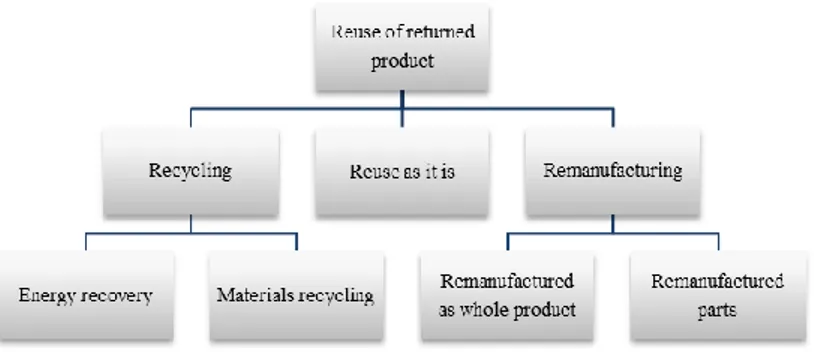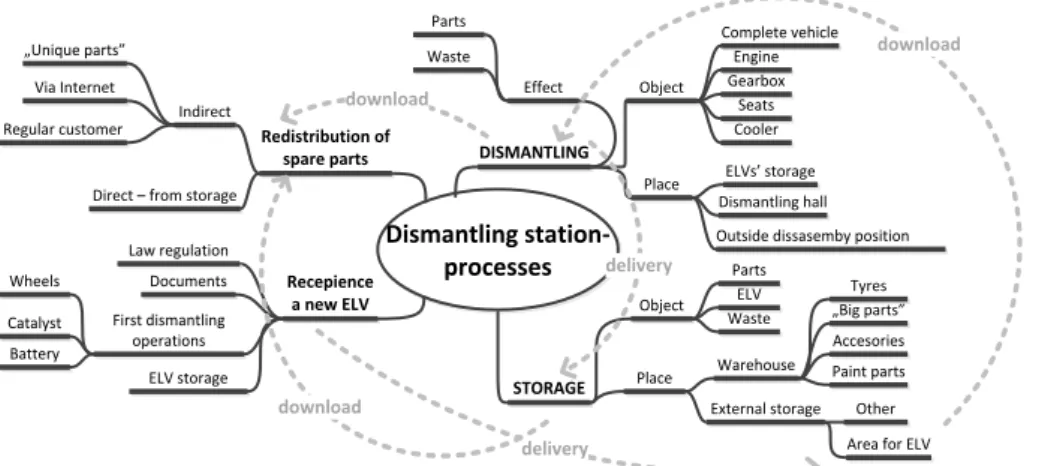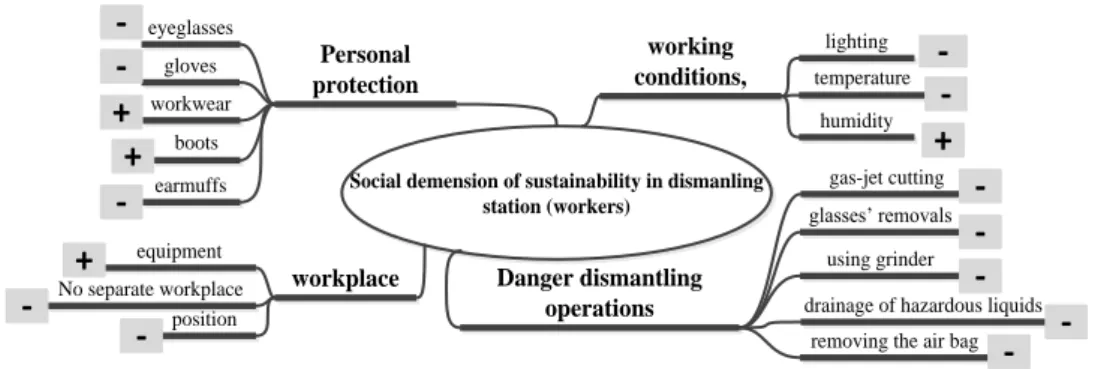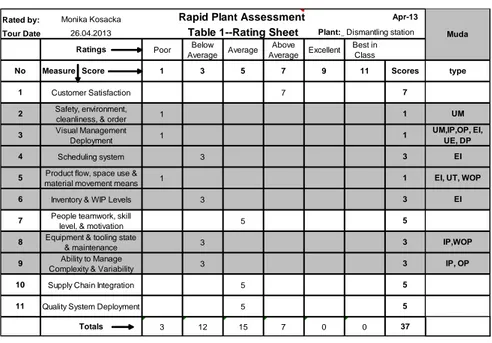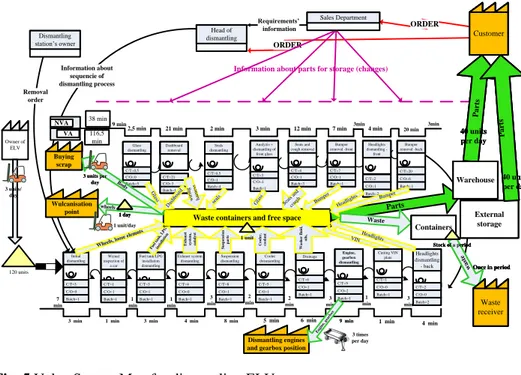ASSESMENT OF SUSTAINABILITY IN DISMANTLING
STATION – CASE STUDY
Monika Kosacka* and Paulina Golińska**
* Faculty of Engineering Management, Poznan University of Technology, Poznan, Strzelecka 11, 60-965, Poland, Email: kosacka.monika@gmail.com ** Faculty of Engineering Management, Poznan University of Technology, Poznan,
Strzelecka 11, 60-965, Poland, Email: paulina.golinska@put.poznan.pl
Abstract Sustainable resources utilization is very actual issue considered in three dimensions:
economic, social and environmental. Products end-of-life management is a key element of sustainable development. Automotive industry is a big supplier of different kinds of waste. End-of-life vehicles are becoming problem in most of the Member Countries. Poland is a country with one of the oldest vehicles feet in EU. It results in a growing trend of the number of old and worn cars, which need to be dismantled and recovered. The objective of this paper is to present an assessment of sustainability in disassembly station. Authors present theoretical background of research, case study description and complex analyses of dismantling process in one of the biggest dismantling stations in Poland with application of following tools: VSM maps, diagram SIPOC and RPA method. The analysis allows to identify main problems which exist in this field and to propose some improvement measures in order to improve the sustainability of dismantling operations.
Paper type: Research paper Published online: 30 April 2014
Vol. 4, No. 2, pp. 135-145 ISSN 2083-4942 (Print) ISSN 2083-4950 (Online)
© 2014 Poznan University of Technology. All rights reserved.
1. INTRODUCTION
The issue of sustainable development has become a global problem and one of the greatest challenges of the twenty-first century, particularly for the automotive industry consuming resources and affecting people, Environment and Economy.
Products end-of-life management is a key element of sustainable development of vehicles as sources of numerous and different kinds of waste. The returned product might be subject to different reuse options. Figure 1 presents the most common reuse options like: reuse-as-is-is, recycling and remanufacturing.
Fig. 1 Reuse options for return products
End-of-life vehicles (ELVs) are a serious problem especially in countries like Poland where old, used cars are dominating. The solution is recycling system with dismantling stations. This paper aims to present and analyze sustainability issues in one of the biggest dismantling station in Poland. The paper consists of five sections. First is presented the background of sustainable development in auto-motive industry. The next section aims to provide discussion on vehicle fleet in Poland. Section 4 is a description of method used to analyze sustainability in dismantling station using: VSM maps, diagram SIPOC and RPA method. In the last section are presented final conclusions.
2. SUSTAINABLE DEVELOPMENT IN THE AUTOMOTIVE
INDUSTRY
"Sustainable development is development that meets the needs of the present without compromising the ability of future generations to meet their own needs” (WCED, 1987). This concept goes includes simultaneous consideration of the three pillars of development - environmental, economic and social in such a way that the development of one of the element is not a threat to others. Sustainable
develop-ment became one of the greatest challenges for companies around the world, particularly for one of the fastest growing industries – automotive industry. That industry is a burden on the environment and people at all phases of car life cycle from designing, through manufacturing (use of resources) and utilizing (emissions to the environment), at end-of-life phase ending. End-of-life vehicles generate, every year in the EU, between eight and nine million tonnes of waste required correct treatment. In response, the EU established Directive aims at making vehicle dis-mantling and recycling more environmentally friendly, sets clear quantified targets for reuse, recycling and recovery of vehicles and their components and pushes producers to manufacture new vehicles also with a view to their recyclability (ELV, 2000).
3. CHARACTERISTICS OF THE VEHICLE FLEET IN POLAND
Vehicle fleet in Europe counts 228 million units (ACEA, 2012), of which 17.9 million became polish cars. There is observed upward trend in the number of cars in the hole world each year. In Poland this number increased 3.4 times to the level of 17.9 million of passenger cars in 2011 from 5.3 million in 1990 (PZPM, 2013).
According to ACEA data the average car age in UE is 8.3 year (2012) when in Poland the average age is almost 15 years old (SAMARb, 2013) in both with
an upward trend - the vehicle fleet is getting old. Poland slowly become Europe's automotive heritage park. Only about 10 % of all vehicles are units below the age of 5 years old. About 70% all vehicle fleet are old cars over 12 years, the biggest group is between the age of 12 and 15 (about 4.2 million units). Disturbing is the fact that the number of new cars (up to 2 years) is decreasing each year, amount of old ones is increasing (GUS, 2011). In the EU the age structure of vehicles below the age of 5 years old determines 32,2 % of all units, but cars older than 10 years were 35,6% of population (ACEA, 2012).
Taking into account facts about: age and number of vehicles, technical con-dition, the number of scrapped cars , 5,0-5,5 % of all vehicles (0.8-1.2 million) should be deregistered. Although an increasing trend in a number of deregistration - 342 352 unregistered vehicles in 2011 (SAMARb, 2013) not enough number
of vehicles get to recycling network created by dismantling stations and car collection points (Ustawa, 2005). Vehicle recycling system in Poland is not working correctly what presents comparisons of the size of the scrapped cars (about 1 million) and the small number of vehicles given to legal dismantling facility (267 889 units in 2011) (SAMARa, 2013). Almost 70% of all scrapped units
is feeding “grey area” – where cars are illegally dismantled for selling spare parts. Those activities are harmful for the Environment.
4. ASSESSEMENT OF THE SUSTAINABILITY
Polish recycling system consists in 2012 of 749 dismantling stations and 120 collection points of vehicles
(SAMAR
b, 2013).
Dismantling station is the“heart” of recycling network aims eliminating the risks of ELV for the Environ-ment, which operates the following activities in ELVs’ area (Ustawa, 2005):
• removing items and hazardous substances, including fluids;
• removing all equipment items from the vehicle and parts suitable for reuse; • removing all components that can be recycled or recovered.
Performing “dismantling business” means many duties regarding: recording, environment protection and waste management regulated by the law. The main issues regulated by the law are inter alia: admission of every vehicle free of charge, esta-blished level of recovery (95%) and recycling (85%), station equipment, appropriate land-use and technical operation realized at appropriate sector of dismantling station.
4.1 Dismantling stations – process analysis
The analysed company is one of the biggest dismantling station operating in Po-land. About 800 cars are processed in this station each year, what results at about 2.5 dismantled cars per day. The company collects end-of life vehicles what is the co-re business. Additionally it offers full service in the field of waste management.
The company does not have a clearly defined organizational structure, however, there can be distinguished several functional areas: administration, sales, disman-tling, transport with 17 workers.
The company proceeds: complete serviceable vehicles, spare parts and waste that may be recovered, recycled or disposed. The main objective of dismantling ELVs is the recycling of parts and environmental protection at the lowest possible cost per operation. Dismantling station structure consists of: car magazine (ar-ea with ELV arranged next to one another with about 120 vehicles capacity), dis-mantling hall linked to magazine of “big parts”, magazines of: tyres, accessories and the paint parts, external storages without any roof placed in a free space. Dis-mantling station products are: spare parts and waste.
The following research approach was applied to analyse and evaluate the sus-tainability issues in the dismantling station:
1. Identification of products and process
2. Identification of sustainability issues: social aspects, economic &environmental aspects
3. Rapid plant assessment (RPA – matrix and questionnaire)
4. Process analysis/mapping (to identified process flow and potential bottlenecks) 5. Identification of waste (muda) for RPA low score areas
Processes realized by dismantling station are presented in Figure 2. The scope of the processes cover: 1) Dismantling including dismantling all vehicle, removing selected part in Customer order but also dismantling particularly units obtained from dismantling all vehicle. Process is realized in 3 places: area of ELVs’ storage, “out-side dismantling position” (free space between dismantling hall and ELVs’ storage, setting up with support), dismantling hall at a lift. If Customer have a wish and there are technical conditions individual dismantling by Customer is allowed. In result of dismantling there are spare parts supplied to appropriate storage or waste placed in right container. 2) Recipience ELVs’– process providing vehicles for dismantling process, where beside formal issue there are first removing operations (tyres, cata-lyst, wheels). 3) Storage: waste, spare parts, ELV-s in warehouses and external con-ditions. 4) Redistribution of spare parts realized directly by selling parts from maga-zines including ELVs or indirect via Internet, by contact with regular customers and motorist’s fans (unique parts).
Dismantling station- processes DISMANTLING Recepience a new ELV STORAGE Redistribution of spare parts Law regulation Documents First dismantling operations ELV storage Wheels Catalyst Battery
Direct – from storage Indirect Complete vehicle Cooler Engine Gearbox Seats Parts Waste Object Effect „Unique parts” Via Internet Regular customer Parts ELV Waste Object Place
Area for ELV Warehouse
External storage Place ELVs’ storage
Dismantling hall Outside dissasemby position
Other „Big parts” Accesories Paint parts Tyres delivery download delivery download download
Fig. 2 Process in dismantling station
All processes realized in dismantling station were analyzed from the perspective of importance of pillars of sustainable development (Table 1) with points from 1(small influence) to 5 (great influence).
Table 1 Importance from sustainability perspective of dismantling processes
Process Pillar of sustainable development Total
Environment Social Economy
Dismantling 5 5 5 15
Reception of new ELV 3 1 5 9
Storage 5 2 4 11
Redistribution 1 1 2 4
In redistribution there are little possibilities of sustainability. The greatest influ-ence is observed in dismantling process what influinflu-enced all pillars in the maximum dimension (15/15). The storage and reception of new ELV are less important but they have to be considered in connection to dismantling process. For this reason this paper focuses at sustainability assessment in dismantling process in connection to storage and recipience of new ELV.
P R O C E S S
INPUT PROCESS OUTPUT CUSTOMER
S
I
P
O
C
1. Car selection from an ELVs’ storage 2. Transport to dismantling position 3. Putting a car on a lift 4. Dismantling process of paricular parts/ assemblies 5. Position cleaning 6. Transportation of a car body to recipient scrap People: · Owner of ELV; · Dismantling station workers (administration, dismantling, selling area) · Customers· Driver of a gun carriage
· People: dismantling worker, forklift operator,
· Information: Customer order, : level of car
completeness, order of removal, technical condition of parts, removal instruction, agreement with thescrap’s recipient, end of work,
· Physical resources: dismantling tools, lift, fire
extinguisher, sorbent, marker, shovel, broom, parts, waste, car’s body, forklift, ELV
SUPPLIERS People: · External CUSTOMER: Customer, Company buying scrap · Internal CUSTOMER: dismantling worker, owner of dismantling station, Sales department worker, Head of dismantling unit
· People: dismantling worker, forklift
operator,
· Information: scrap’s weight, removal
instruction,
· Physical resources: ELV (allocated for
dismantling, prepared for it, set to lift) dismantling tools, lift, VIN plate, parts, waste, car’s body, forklift
Fig. 3 SIPOC diagram for dismantling an ELV process
Dismantling process of an ELV is very complex and precious from sustainabil-ity perspective. Presentation of dismantling process (Fig. 3) is a Six Sigma meth-odology tool – SIPOC diagram. Process has got many suppliers – not only forklift operator who physically charges an ELV from the storage (effect of ELV recep-tion), but also: customers, owners of ELV and workers of dismantling station. Sup-pliers should be stimulated in appropriate way. There are many resources at the input and output side. Output refers to storage process of waste and parts for redis-tribution. Customers of this process are divided in 2 groups: external and internal.
4.2 Dismantling station – social aspects of sustainability
Social aspects are considered in relation to people hired at dismantling station and the local community. Local community is affected by dismantling station in a little way. Plant is surrounded by trees, the dismantling hall and ELVs’ storage are placed in the back of the company, away from the street, so the noise are inof-fensive. Always there is a risk of breakdown resulted in air and water pollution. Plant has not destructed the landscape – there are no heaps of car waste, tires, car wrecks and general disorder. Additionally, area where station is located is rather industrial one. The other side are social aspects in workers’ perspective (Fig. 4).
Social demension of sustainability in dismanling station (workers) working conditions, lighting temperature humidity workplace equipment No separate workplace position Danger dismantling operations Personal protection eyeglasses gloves workwear boots
earmuffs gas-jet cutting
glasses’ removals using grinder
drainage of hazardous liquids removing the air bag
-+
-+
-+
+
-Fig. 4 Social dimension of sustainability in dismantling station
There are considered: danger dismantling operations, working conditions, per-sonal protection means and workplace. Each factor affected worker was given +/- what indicates positive or negative influence from the sustainable development per-spective. There is a big area of improvements in this area. If worker equip in proper personal protection means, the level of risks associated with the danger dismantling operations would decrease.
4.3 Economic and environment aspect of sustainability
There is undeniable fact that dismantling station promotes sustainable development particularly due to efficient utilization of resources – it transforms danger waste (ELV) to spare parts demanded by the market and waste determines the object of recycling and disposal in the last resort. Reusing spare parts safe to use helps to save materi-als and energy needed to produce new one. Processing car waste reduces the num-ber of garbage in landfills, forests and other places where car wrecks are abandoned. Beside efficient utilization there is environmental issue what is directly linked to dis-mantling operations and waste management, particularly those hazardous.
To obtain efficient resource utilization there should be no waste of resources. Assessment of sustainability from resource effectiveness perspective will be pre-sented with the Rapid Plant Assessment (RPA) – a method derived from Lean con-ception, elaborated in late 90’s by Goodson (2002). It is a tool for assessment of the plant’s leanness. The RPA method includes: 1) Rating Sheet (Table 3) – evaluation of 11 areas in plant. The scale for scoring includes 6 options assessed by increased of 2 point for each subsequent grade (“poor” - 1 point, “below aver-age” - 3 points, the maximum - 11 points). This rating sheet helps to identify the categories of strength and weakness. Categories with low ratings are having the potential for improvement, and should be explored first to provide the leanness
(Sundin, 2004). 2) RPA Questionnaire. It provides 20 yes/no questions. The total number of yeses on it is an indicator of a plant’s leanness.
During the case study performed in dismantling station it turned out, that some modification of this method are needed in order to better explore the leanness po-tential by waste elimination. Authors decided to combined the RPA questionnaire with 8 muda (waste types): overproduction (OP), inappropriate processing (IP), waiting for operations (WOP), unnecessary transportation (UT), unnecessary mo-tion (UM), excess inventory (EI), defects products (DP), Underutilizamo-tion of Em-ployees (UE). An expert method was applied to make this classification. Matrix was elaborated which correlate 20 RPA questions with 8 muda types. The matrix was sent to over 30 experts having experience in lean management. The authors received back 17 answers. Based on the received answers the initial RPA question-er was extended with additional column refquestion-erring to the muda type.
Table 2 RPA Rating sheet
Rated by:_______________Monika Kosacka Rapid Plant Assessment Apr-13
Tour Date:______________26.04.2013 Table 1--Rating Sheet Plant:________________Dismantling station
Ratings Poor Below
Average Average Above Average Excellent
Best in Class
No Measure Score 1 3 5 7 9 11 Scores type
1 Customer Satisfaction 7 7
2 Safety, environment,
cleanliness, & order 1 1 UM
3 Visual Management
Deployment 1 1
UM,IP,OP, EI, UE, DP
4 Scheduling system 3 3 EI
5 Product flow, space use &
material movement means 1 1 EI, UT, WOP
6 Inventory & WIP Levels 3 3 EI
7 People teamwork, skill
level, & motivation 5 5
8 Equipment & tooling state
& maintenance 3 3 IP,WOP
9 Ability to Manage
Complexity & Variability 3 3 IP, OP
10 Supply Chain Integration 5 5
11 Quality System Deployment 5 5
Totals 3 12 15 7 0 0 37
Muda
In RPA rating sheet plant obtained only 37 points. With grey colour there are areas with results below the average, chosen for further investigation regarding muda elimination. After considering the results of RPA sheets identified types of waste in the dismantling station, using a catalogue of muda: overproduction (OP), inappropriate processing (IP), waiting for operations (WOP), unnecessary transportation (UT), unnecessary motion (UM), excess inventory (EI), defects products (DP) , Underutilization of Employees (UE). There are 7 areas where there are different kind of muda, requiring appropriate activity to eliminate them. To better identify resources and material flow in dismantling process there were
made couple maps by Value Stream Mapping (VSM). Due to the limited space there is presented only a map for dismantling whole car (Fig. 5).
Requirements’ information
Information about sequencie of dismantling process
Waste containers and free space
Parts
7 min
3 min 1 min 4 min 8 min 5 min
20 min 4 min 7 min 12 min 3 min 2 min VA VIN ORDER ORDER Removal order 1 min 3 min 1 min 3 min 2 min min2 6 min 3 min 9 min 1 min 1 min 3 min 4 min
Information about parts for storage (changes)
3min 3min 21 min 9 min 2,5 min 116,5 min 38 min NVA Waste 120 units Owner of ELV 3 units/ day Initial dismantling C/T=3 C/O=0 Batch=1 Wizual inspection of a car C/T=1 C/O=1 Batch=1 Fuel tank/LPG installation dismantling C/T=3 C/O=1 Batch=1 Exhaust system dismantling C/T=4 C/O=0 Batch=1 Suspension dismantling C/T=8 C/O=1 Batch=1 Cooler doismantling C/T=5 C/O=1 Batch=1 Drainage C/T=6 C/O=1 Batch=1 Engine, gearbox dismantling C/T=9 C/O=2 Batch=1 Cutting VIN plate C/T=1 C/O=0 Batch=1 Headlights dismantling - back C/T=2 C/O=0 Batch=2 Initial dismantling C/T=3 C/O=0 Batch=1 Wizual inspection of a car C/T=1 C/O=1 Batch=1 Fuel tank/LPG installation dismantling C/T=3 C/O=1 Batch=1 Exhaust system dismantling C/T=4 C/O=0 Batch=1 Suspension dismantling C/T=8 C/O=1 Batch=1 Cooler doismantling C/T=5 C/O=1 Batch=1 Drainage C/T=6 C/O=1 Batch=1 Engine, gearbox dismantling C/T=9 C/O=2 Batch=1 9 min Dismantling engines and gearbox position
3 times per day
Cutting VIN
plate dismantling Headlights
- back C/T=2 C/O=0 Batch=2 Customer External storage Pa rts P a rt s Engin e, gearb ox 40 units per day Warehouse Containers w as te Stock of a period Waste receiver Once in period 40 units per day Customer External storage Pa rts P a rt s Bumper removal -back C/T=20 C/O=6 Batch=1 Headlights dismantling - front C/T=2 C/O=1 Batch=2 Bumper removal -front C/T=7 C/O=1 Batch=1 Seats and cough removal C/T=4 C/O=1 Batch=3 Analyzis + dismantling of front glass C/T=3 C/O=1 Batch=1 Seals dismantling C/T=0,5 C/O=1 Batch=4 Dashboard removal C/T=21 C/O=3 Batch=1 Glass dismantling C/T=0,5 C/O=0 Batch=5 40 units per day Warehouse Containers w as te Stock of a period Waste receiver Once in period 40 units per day Customer External storage Wheels, loo se elemnts E x h a u st sy st em , ca ta ly st S u sp en si o n p a rt s Pa rts P a rt s Fuel tank , LP G inst allati on C o o le r, co o la n t W a sh er f lu id , o il s, Bumper removal -back C/T=20 C/O=6 Batch=1 Headlights dismantling - front C/T=2 C/O=1 Batch=2 Bumper removal -front C/T=7 C/O=1 Batch=1 Headlights Seats and cough removal C/T=4 C/O=1 Batch=3 Analyzis + dismantling of front glass C/T=3 C/O=1 Batch=1 Seals dismantling C/T=0,5 C/O=1 Batch=4 Dashboard removal C/T=21 C/O=3 Batch=1 Glass dismantling C/T=0,5 C/O=0 Batch=5 40 units per day Warehouse Containers w as te Stock of a period Waste receiver Once in period 40 units per day wheels Wulcanisation point 1 unit/day 1 day 1 day Buying scrap Body 3 units per day Sales Department Head of dismantling 1 day Buying scrap Body 3 units per day Dismantling station’s owner Bump er Headl ights Bumper Seat s and coug h Gla ss seal s w ir in g h ar n es s Dashb oard G lass 1 unit
Fig. 5 Value Stream Map for dismantling ELV – at present
Dismantling process was analyzed in the context of places where value is generated in the process. Value - includes everything which customer wants to pay for. The most complex is dismantling all vehicle process with many operations resulting in waste and parts for sale. Actually there is lack of concrete information about list of parts which will be stored. Presently a worker puts components arising at different stages of disassembly directly into containers where they are stored either in the free space on the bench disassembly and around it. There is no order at workplace. Share of non-value-added time in all process time is significant – almost 25%.
5. CONCLUSION
The paper presents the challenges for sustainability development in dismantling station. Social aspects should focus on proper personal protection means, im-provement of working condition and workplace including ergonomic position at work and workplaces separated for each dismantling operation with proper equipment. In environmental aspect there is need for right waste management
by proper system of storage (containers), improving drying technology (hazardous liquids). The economic aspect should focus on effective resource utilization (linked to environmental issues). There are following challenges:
• elimination of unnecessary stock;
• reduction of dismantling cycles by eliminating of unnecessary transport and waiting times (5S, Kaizen);
In both, environmental and economic perspective, there is a big need of intro-duction a remanufacturing process for some parts. At present dismantling station storage a specified catalogue of parts, rest of car parts became a waste. This pro-cess let reuse some parts after remanufacturing, what is valuable – there are less waste, part life cycle is extended, what affects cheaper parts for Customer the same as removed from ELV parts. The right policy of waste management and spare parts redistribution is an evidence of sustainability in this dismantling station.
The biggest problem of polish dismantling station is that not enough ELVs are directed to legal stations became a part of national recycling network.
ACKNOWLEDGEMENTS
This paper refers to the research financed by the Narodowe Centrum Badan i Rozwoju NCBiR (National Centre for Research and Development) in the frame-work of the German-Polish cooperation for sustainable development, project ”Sus-tainability in remanufacturing operations (SIRO)”, grant no WPN/2/2012.
REFERENCES
ACEA, (2012) “The automobile industry pocket guide”, available at:
www.acea.be/images/uploads/files/ACEA_POCKET_GUIDE_2012_UPDATED.pdf (accessed 21 June 2013).
ELV Directive (ELV), (2000), Directive 2000/53/EC of the European Parliament and of the
Council of 18 September 2000 on end-of life vehicles.
Główny Urząd Statystyczny (GUS), (2011), „Transport. Wyniki działalności w 2011r.”, available at: www.stat.gov.pl/gus/5840_748_PLK_HTML.htm (accessed 20 June 2013).
Goodson R. E.,(2002), “Read a Plant – fast”, Harvard Business Review.
Polski Związek Przemysłu Motoryzacyjnego (PZPM), (2013), „Park pojazdów zarejestrowanych
w Polsce 1990-2011”, available at:
www.pzpm.org.pl/pl/Rynek-motoryzacyjny/Park-pojazdow-zarejestrowanych (accessed 21 June 2013).
SAMAR(a), (2013), „Co i dlaczego Polacy wyrejestrowali w latach 2007-2011?”, available at:www.samar.pl/wiadomosci/co-i-dlaczego-polacy-wyrejestrowali-w-latach-2007-2011-?locale=pl_PL(accessed 21 June 2013).
SAMAR(b), (2013), „Park samochodów 2012 w ofercie IBRM Samar”, available at:
www.samar.pl/__/3/3.a/72164/3.sc/11/park-samochod%F3w-2012-w-ofercie-ibrm-samar.html?locale=pl_PL (accessed 21 June 2013).
Sundin, E.,(2004), “Product and Process Design for Successful Remanufacturing”, Linköping Studies in Science and Technology Dissertation No. 906, Production Systems, Dept. of Mechanical Engineering Linkoping Uni., Sweden.
Ustawa z dnia 20 stycznia 2005 r. o recyklingu pojazdów wycofanych z eksploatacji (Dz. U. Nr 25, poz. 202 z późn. zmianami).
World Commission on Environment and Development (WCED), (1987), " Report of the World Commission on Environment and Development”, available at: www.un-documents.net/our-common-future.pdf (accessed 22 June 2013).
BIOGRAPHICAL NOTES
Monika Kosacka is an student of doctoral studies at Poznan University
of Technology (PUT). She received her master degree in Industrial Engineering from PUT in 2012. Her research interests are in area of :materials flow manage-ment, reverse logistics, dismantling.
Paulina Golinska is an assistant professor at Poznan University of Technology
(PUT). She received her Ph.D. degree in Industrial Engineering from PUT in 2008. Her research interests are in area of production control, materials flow mana-gement, reverse logistics, remanufacturing. She is Board Member of the Inter-national Foundation of the Logistics and Supply Chain Management (IFLS) and member of the Polish Logistics Association.
